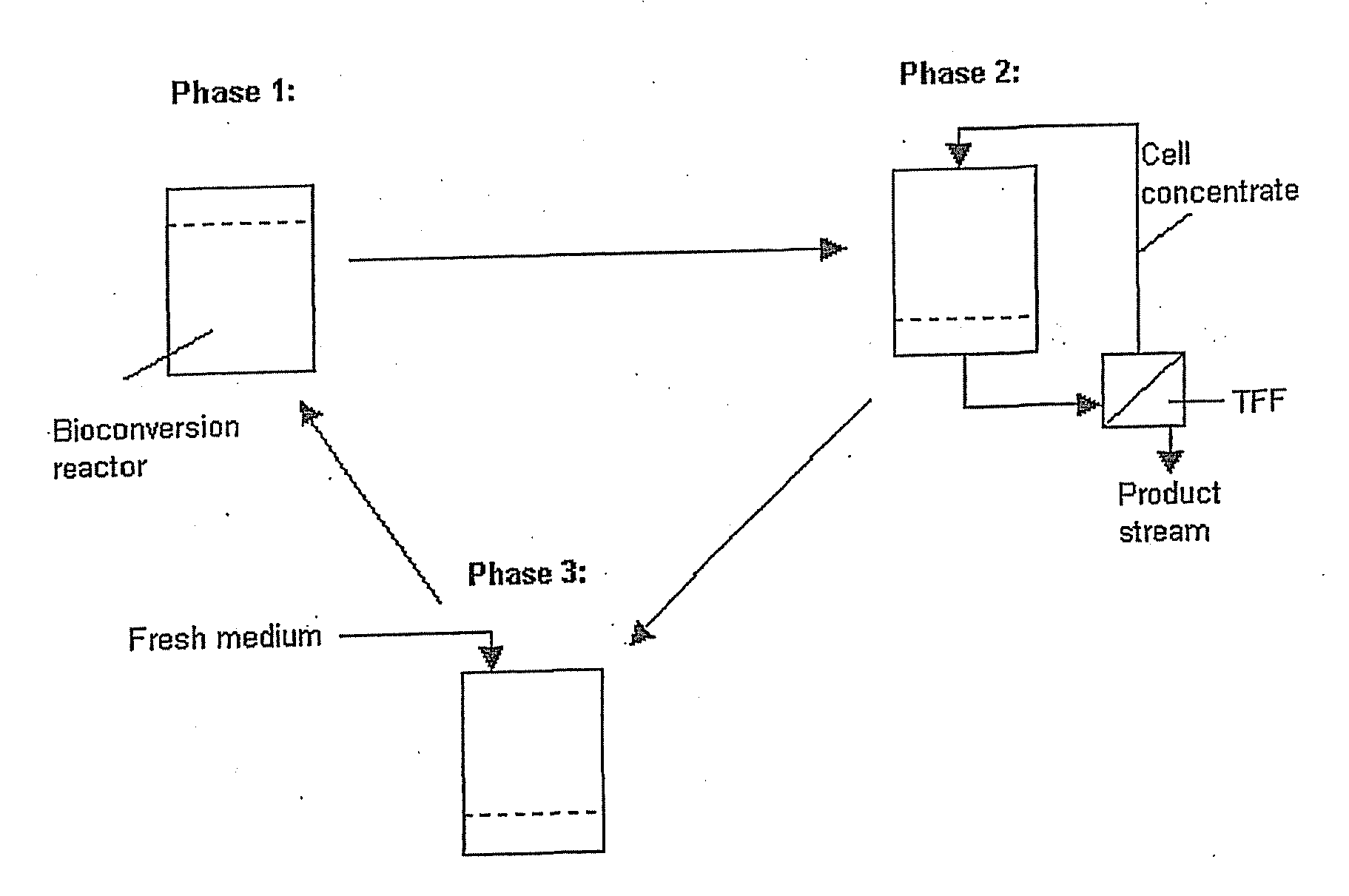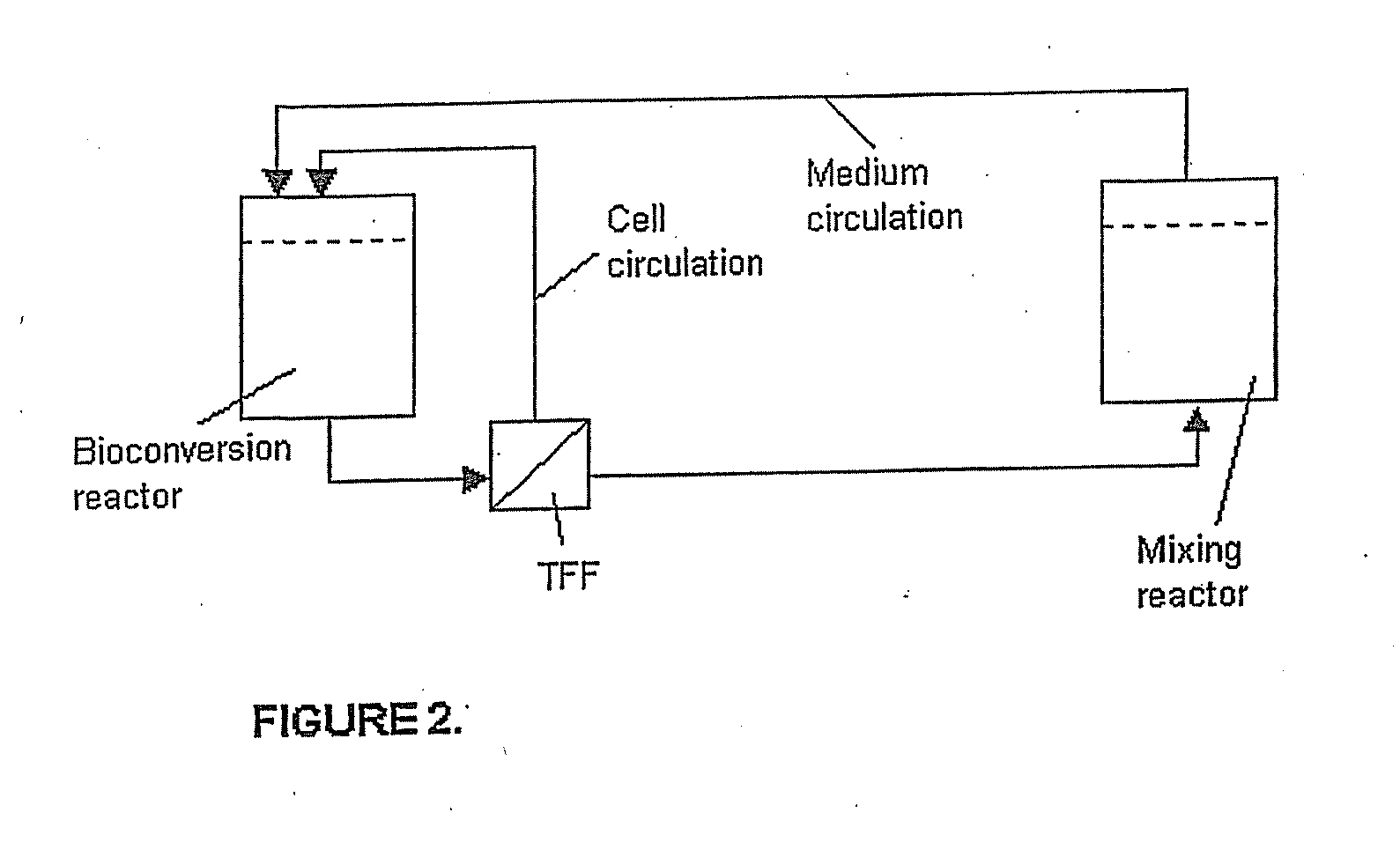Process for Producing D-Mannitol
- Summary
- Abstract
- Description
- Claims
- Application Information
AI Technical Summary
Benefits of technology
Problems solved by technology
Method used
Image
Examples
example 1
Production of Cells for the Bioconversion Phases 1
[0034]A bench-top bioreactor containing 9.7 L of nutrient-rich fermentation medium (Soetaert et al., 1999) was inoculated with 300 mL of a 16-h cell culture of Leuconostoc pseudomesenteroides ATCC-12291 grown in an inoculation medium (Soetaert et al., 1999). The temperature of the growth medium (10 L) was set first at 20° C. and after 56 h raised to 25° C. The pH was controlled at 5.0. The solution was slowly agitated.
[0035]After about 66 hours the cultivation was stopped and the cells recovered by tangential flow filtration (Pellicon® 2 Mini Holder and Biomax® 1000 (V screen) membrane, Millipore Corp., USA). From an initial volume of 10.9 L (˜3 g dry cell weight / L) a 0.7-L cell concentrate (˜47 g dry cell weight / L) was obtained by this filtration technique. The cell-free permeate (10.2 L) could thereafter be used for study of mannitol recovery. The cell concentrate can be used as the initial biomass for the processes described in Ex...
example 2
Production of Cells for the Bioconversion Phases 2
[0037]A bench-top bioreactor containing 1.9 L of MRS growth medium (40 g / L glucose) was inoculated with 100 mL of a 10-h cell culture of Leuconostoc mesenteroides ATCC-9135 also grown in a MRS growth medium (30 g / L glucose). The temperature and pH of the growth medium (2 L) were set at 30° C. and 6.0, respectively. The solution was slowly agitated.
[0038]About 9.5 hours later the cells were harvested by centrifugation. The cell pellet was then suspended in a fresh bioconversion medium (See Examples 3-5).
example 3
Production of Mannitol by Bioconversion in a Batch Mode (FIG. 1)
[0039]The cell pellets obtained in Example 2 was suspended with fresh bioconversion medium and transferred aseptically into a bioconversion reactor. The total volume of the solution was 425 mL and it had the following initial composition: 100 g / L fructose, 50 g / L glucose, 1 g / L tryptone, 0.5 g / L yeast extract, 2.62 g / L K2HPO4.3H2O, 0.2 g / L MgSO4, and 0.01 g / L MnSO4. The cell concentration during the bioconversion was approximately 10 g dry cell weight / L.
[0040]The temperature control was set at 30° C. and the pH was controlled at 5.0 with 3 M NaOH. The solution was slowly agitated.
[0041]After 4.5 hours of bioconversion time the cells had consumed all of the sugars and the experiment was ended. The average volumetric mannitol productivity for the process was 20.7 g / L / h. The mannitol yield from fructose was 91.2 mole-%.
[0042]Furthermore, the product solution and cells can be separated by e.g. TFF, and the cell concentrate ...
PUM
 Login to View More
Login to View More Abstract
Description
Claims
Application Information
 Login to View More
Login to View More - R&D
- Intellectual Property
- Life Sciences
- Materials
- Tech Scout
- Unparalleled Data Quality
- Higher Quality Content
- 60% Fewer Hallucinations
Browse by: Latest US Patents, China's latest patents, Technical Efficacy Thesaurus, Application Domain, Technology Topic, Popular Technical Reports.
© 2025 PatSnap. All rights reserved.Legal|Privacy policy|Modern Slavery Act Transparency Statement|Sitemap|About US| Contact US: help@patsnap.com



